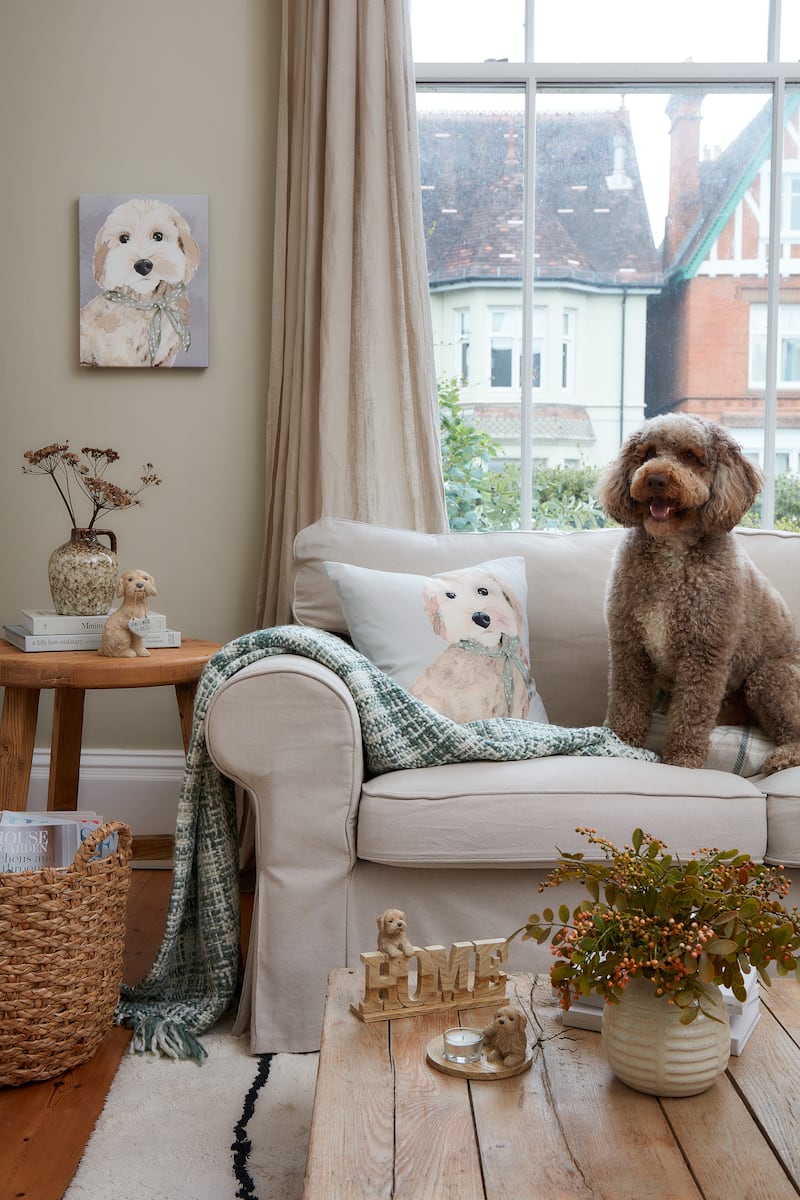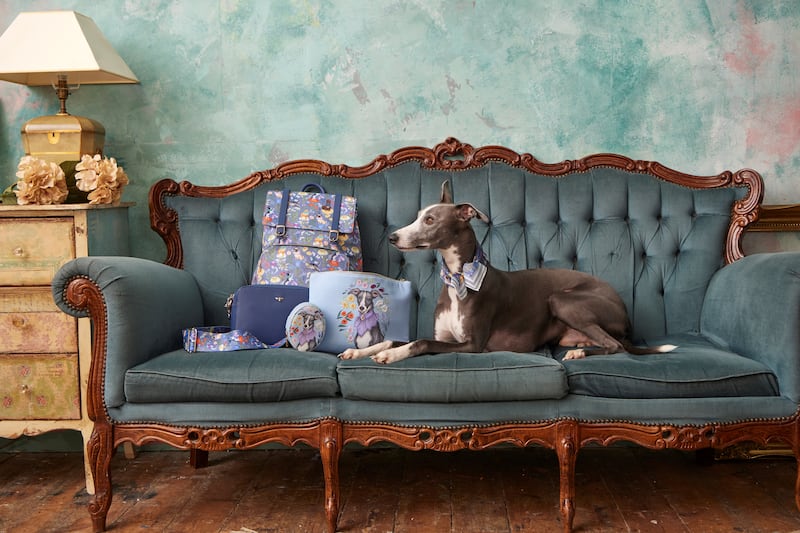There’s always been a whiff of irony to the phrase “it’s a dog’s life”, but the Cambridge Dictionary may need to rethink its definition if actor Demi Moore’s Chihuahua, Pilaf, is any sort of standard-bearer for the current state of canine living.
In recent months, Moore’s minuscule furry friend has sat front row at Paris fashion week, attended a Saturday Night Live after-party and watched Rafael Nadal play at the French Open in a VIP box. The toy breed is carried around protectively by Moore in a custom Max Mara sling and has a wardrobe of high-fashion clothes and accessories that includes Chopard necklaces and Gucci hats.
“Mommy’s little mouse”, as Moore refers to her, has an Instagram account with more than 24k followers and on it you’ll see her being bottle-fed, dressed-up and cuddled by A-list actors. This does not look like a very unhappy and unpleasant existence to me.
But then, I’m looking at Pilaf’s jet-setting, star-studded luxury lifestyle through a human lens, and this is a mistake, explains Orla Doherty, an associate lecturer in animal behaviour at UCD’s veterinary college.
“Dogs are a completely different species with a whole set of unique behaviours, needs, likes and dislikes,” she says.
Fussing over a dog the way a child does over his or her doll is no longer just a celebrity eccentricity. Back in the early noughties we scoffed at Paris Hilton and the “handbag” dog that peeked out of her quilted Chanel tote, writing her off as an overindulged heiress, but these days more and more of us are viewing our pets as substitute children and spoiling them accordingly.
“I’ve seen this trend grow in the past 10 years,” Doherty says, “and while it’s wonderful to see dogs being treated as a member of the family, if taken too far, the animal’s specific needs can get lost.”
With 49 per cent of Irish households owning a dog, according to a 2022 survey carried out on behalf of the rehoming and dog rescue charity Dogs Trust, there’s a lot of money to be made from the kind of pet paraphernalia that goes with pampered pooches. From pet bakeries selling birthday cakes and cafes serving puppuccinos, to grooming parlours offering mud baths, blueberry facials and milk thistle “pawdicures”, the products and services sold for pets are marketed to sound desirable to their owners.
And they’re not confined to specialist pet stores; you can pick up an at-home spa kit for your pet along with flat-pack furniture and fake plants in Ikea.
This commodification of dog ownership is encouraging the humanising of our pets and it has potentially serious side effects for both their physical and mental health, from obesity to aggression. It’s not unusual to see a dog being pushed in a stroller like a newborn, with pet pushchairs available to buy anywhere from Harvey Norman to Amazon.
Doherty says that carrying or wheeling a dog around and preventing it from being at ground level deprives it of the opportunity to sniff and to have social contact with its own species.
“Think of it like this,” she says. “If you were adopted by an alien species and you only saw another human every so often, all of your instincts would be to approach that person and have a human conversation.”
Doherty says the only justification for wheeling a dog in a pram is if that dog has had surgery or suffers from a weakness in its hind legs.
“A healthy dog should be on its feet and for an average-sized, adult dog ideally walked for at least half an hour twice daily,” she explains.

Liane Seiler runs the Cork Animal Behaviour Clinic and has a special interest in canine socialisation. She agrees that walking dogs on a lead is far healthier for the dog’s physical and mental health.
“If a dog finds itself in an uncomfortable situation, it can back away on a lead. If it’s being carried in a sling, the only way it can communicate discomfort is through aggression,” she explains.
This kind of needless cosseting prevents dogs from exploring their own canine nature and it’s shifting how they relate to their surroundings. Dogs are now more commonly seen in human spaces – from dog-friendly cafes and restaurants to offices – than in fields chasing sticks. While this may give us as owners more freedom and independence, it doesn’t bring our pets the same benefits.
Dogs have fewer opportunities to be off lead and they live more confined lives than ever before. This also means they encounter fewer stimuli, which can result in erratic behaviour.
“If dogs could choose their way of life, they would live outside in a pack,” Doherty explains. “They would be hunting, seeking out shelter, water and companionship. Nowadays owners provide all of these essentials, so if the dog is not walked often enough to compensate, it will seek stimulation in other ways, like barking at the postman or shredding the post. This behaviour can become compulsive and extremely problematic for both the dog and its owner.”
With a greater number of dogs spending more time indoors, pets are now shaping how we curate our interiors. According to a survey by decorating app Redecor earlier this year, an enormous 78 per cent of respondents consider their pets when making interior design decisions. Emma Delaney, interior designer at Dublin lifestyle store April and the Bear, says she has worked with plenty of people whose pets have had a huge influence on the design of their homes.
“We work with a lot of clients who have pets as part of their brief,” she explains. “From furniture to decorative cushions, pets impact their choice of everything, with owners looking to purchase furniture that is practical but gorgeous too.”

It’s being dubbed “pet-sthetics” and while the buzz word might be new, the practice has precedent; in the 18th century, French queen Marie Antoinette commissioned beds and kennels for her lapdogs made of velvet and silk to co-ordinate with her elaborate royal suite.
It all speaks to the privileging of pets, which Doherty says is leading to serious behavioural problems, including aggression towards owners themselves. Melanie Kevelighan, PR and communications officer at Dogs Trust, says unwanted behaviour is the most common reason given by owners who surrender their dogs.
“Last year we received 3,967 surrender requests from people looking to relinquish their dogs into our care; the highest number we have ever recorded since opening our centre in 2009,” says Kevelighan.
Doherty says owners are failing to recognise the importance of basic obedience training.
“There are five important commands that every dog should understand: ‘sit’, ‘lie down’, ‘go to bed’, ‘come here’ and ‘stay’,” she explains.
Seiler describes a good owner/dog relationship as that of a teacher/pupil. “For a dog’s own wellbeing, there have to be rules,” she says. “Firm boundaries give dogs a feeling of security,” she adds.
Without this, anxiety levels can soar and Doherty reveals this is one of the most common issues animal behaviourists are asked to treat. While she has yet to encounter a pooch who has sat front row at fashion week, she says there are plenty of everyday examples of “human” situations that can be stressful for dogs, citing music festivals and parades as examples.

“Including your dog on a family outing might not be the best thing for the dog,” she explains. “Parades and festivals often have loud music, unfamiliar noises and children running around; dogs don’t understand these environments so they can feel terrifying. A dog doesn’t know that it’s St Patrick’s Day.”
Doherty advises owners to walk their dogs in the morning and leave them at home to rest while the family goes out and enjoys the occasion.
Seiler believes that some owners lose sight of their dog’s needs, focusing instead on activities that make them feel good.
“Most dogs I know would not enjoy a ‘spa’ treatment,” she says.
Doherty suggests that owners tempted to “spoil” their dog in this way should ask themselves two questions: what scientific evidence is there that canine skin will benefit from the experience? and will the handling and restraint required frighten the dog?
Seiler says most dogs don’t like long cuddles either: “Studies have shown that dogs prefer short bouts of affection.”
It seems that pets have become an emotional crutch for many of us. At a time when Ireland has the highest levels of loneliness in Europe, according to a study carried out last year by the European Commission’s Joint Research Centre, we’re becoming overly dependent on our dogs as a source of emotional connection. Galway-based psychotherapist Mary Lynn works with many clients experiencing loneliness and isolation who put all of the focus and energy they once invested in connecting with friends and family into their pets.
“As humans we crave connection and touch,” she explains. “These things are integral to our existence and survival. But just as dogs need to interact with other dogs and behave like animals, so we as humans need to be around other people. Dogs can’t fill this void.”

















